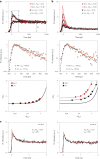Spin-exchange carrier multiplication in manganese-doped colloidal quantum dots
- PMID: 37443379
- PMCID: PMC10390332
- DOI: 10.1038/s41563-023-01598-x
Spin-exchange carrier multiplication in manganese-doped colloidal quantum dots
Abstract
Carrier multiplication is a process whereby a kinetic energy of a carrier relaxes via generation of additional electron-hole pairs (excitons). This effect has been extensively studied in the context of advanced photoconversion as it could boost the yield of generated excitons. Carrier multiplication is driven by carrier-carrier interactions that lead to excitation of a valence-band electron to the conduction band. Normally, the rate of phonon-assisted relaxation exceeds that of Coulombic collisions, which limits the carrier multiplication yield. Here we show that this limitation can be overcome by exploiting not 'direct' but 'spin-exchange' Coulomb interactions in manganese-doped core/shell PbSe/CdSe quantum dots. In these structures, carrier multiplication occurs via two spin-exchange steps. First, an exciton generated in the CdSe shell is rapidly transferred to a Mn dopant. Then, the excited Mn ion undergoes spin-flip relaxation via a spin-conserving pathway, which creates two excitons in the PbSe core. Due to the extremely fast, subpicosecond timescales of spin-exchange interactions, the Mn-doped quantum dots exhibit an up-to-threefold enhancement of the multiexciton yield versus the undoped samples, which points towards the considerable potential of spin-exchange carrier multiplication in advanced photoconversion.
© 2023. The Author(s).
Conflict of interest statement
The authors declare no competing interests.
Figures











Similar articles
-
Highly efficient carrier multiplication in inverted CdSe/HgSe quantum dots mediated by magnetic impurities.Nat Commun. 2025 Mar 26;16(1):2952. doi: 10.1038/s41467-025-58066-0. Nat Commun. 2025. PMID: 40140654 Free PMC article.
-
Mn(2+)-Doped CdSe/CdS Core/Multishell Colloidal Quantum Wells Enabling Tunable Carrier-Dopant Exchange Interactions.ACS Nano. 2015 Dec 22;9(12):12473-9. doi: 10.1021/acsnano.5b05903. Epub 2015 Nov 26. ACS Nano. 2015. PMID: 26567872
-
Enhanced carrier multiplication in engineered quasi-type-II quantum dots.Nat Commun. 2014 Jun 18;5:4148. doi: 10.1038/ncomms5148. Nat Commun. 2014. PMID: 24938462 Free PMC article.
-
Carrier Multiplication Mechanisms and Competing Processes in Colloidal Semiconductor Nanostructures.Materials (Basel). 2017 Sep 18;10(9):1095. doi: 10.3390/ma10091095. Materials (Basel). 2017. PMID: 28927007 Free PMC article. Review.
-
PbSe-Based Colloidal Core/Shell Heterostructures for Optoelectronic Applications.Materials (Basel). 2014 Oct 30;7(11):7243-7275. doi: 10.3390/ma7117243. Materials (Basel). 2014. PMID: 28788244 Free PMC article. Review.
Cited by
-
Highly efficient carrier multiplication in inverted CdSe/HgSe quantum dots mediated by magnetic impurities.Nat Commun. 2025 Mar 26;16(1):2952. doi: 10.1038/s41467-025-58066-0. Nat Commun. 2025. PMID: 40140654 Free PMC article.
-
Rational Doping Strategy to Build the First Solution-Processed p-n Homojunction Architecture toward Silicon Quantum Dot Photodetectors.Small Sci. 2024 Oct 6;4(12):2400367. doi: 10.1002/smsc.202400367. eCollection 2024 Dec. Small Sci. 2024. PMID: 40213481 Free PMC article.
-
Hot-carrier trapping preserves high quantum yields but limits optical gain in InP-based quantum dots.Nat Commun. 2025 Jul 7;16(1):6249. doi: 10.1038/s41467-025-61511-9. Nat Commun. 2025. PMID: 40623991 Free PMC article.
-
Inverted CdSe/PbSe Core/Shell Quantum Dots with Electrically Accessible Photocarriers.ACS Energy Lett. 2025 Feb 5;10(2):1062-1071. doi: 10.1021/acsenergylett.4c03502. eCollection 2025 Feb 14. ACS Energy Lett. 2025. PMID: 39974327 Free PMC article.
-
Nanobioprospecting of photoautotrophs for the fabrication of quantum dots: mechanism and applications.Front Chem. 2024 Oct 15;12:1458804. doi: 10.3389/fchem.2024.1458804. eCollection 2024. Front Chem. 2024. PMID: 39473564 Free PMC article. Review.
References
-
- Werner JH, Kolodinski S, Queisser HJ. Novel optimization principles and efficiency limits for semiconductor solar cells. Phys. Rev. Lett. 1994;72:3851–3854. - PubMed
-
- Nozik AJ. Quantum dot solar cells. Phys. E. 2002;14:115–120.
-
- Padilha LA, et al. Carrier multiplication in semiconductor nanocrystals: influence of size, shape, and composition. Acc. Chem. Res. 2013;46:1261–1269. - PubMed
-
- Klimov VI. Multicarrier interactions in semiconductor nanocrystals in relation to the phenomena of Auger recombination and carrier multiplication. Ann. Rev. Condens. Matter Phys. 2014;5:285–316.
-
- Schaller RD, Klimov VI. High efficiency carrier multiplication in PbSe nanocrystals: implications for solar energy conversion. Phys. Rev. Lett. 2004;92:186601. - PubMed
LinkOut - more resources
Full Text Sources

